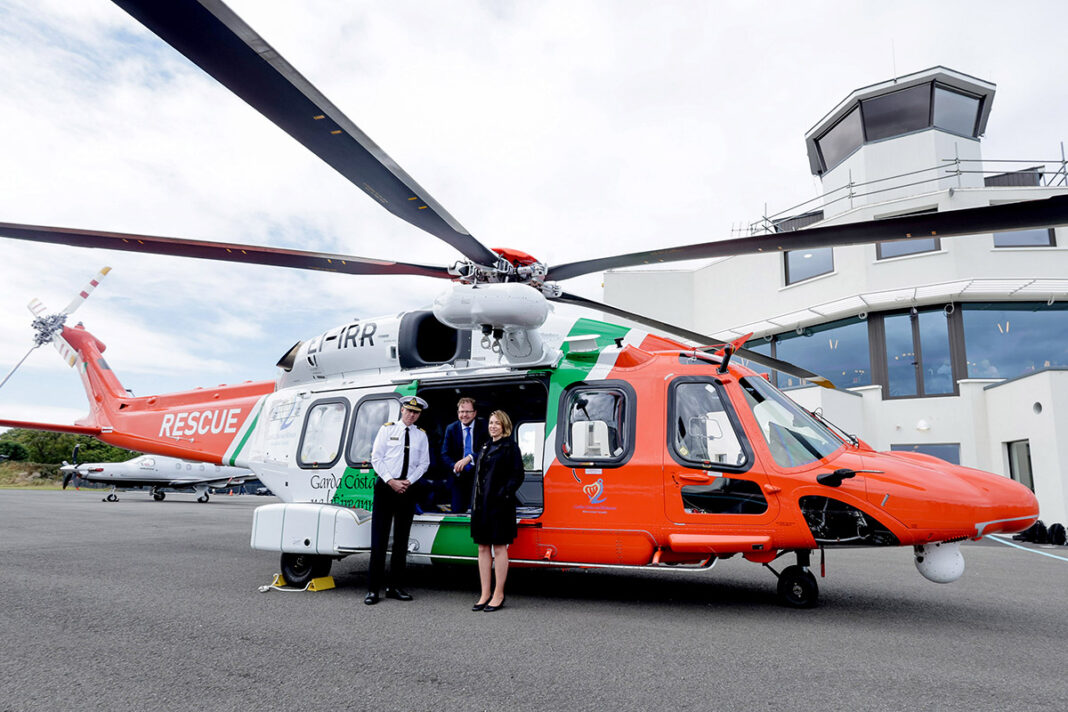The first of six AW189 helicopters which will operate the new aviation search and rescue service for the Irish Coast Guard, has arrived in Ireland.
The August Westland 139 (AW139) helicopter arrived at Weston Airport in Dublin this week from Gossport in South East England. Five of the six aircraft, which will be operated by Bristow Ireland, will be newly-built.
The helicopters will be stationed at Weston (Dublin), Sligo, Waterford and Shannon, providing day and night, year-round availability. The Fixed Wing aircraft service will be located in Shannon.
The fleet will enable the Irish Coast Guard to continue to provide world-class maritime, coastal and inland Search and Rescue services, which have saved the lives of over 300 people in 2024 alone. The aircraft fleet will also be used for environmental monitoring, and for other essential services including helicopter emergency medical and Air Ambulance Services on behalf of the HSE and National Ambulance Service.
Minister of State at the Department of Transport with responsibility for the Coast Guard, James Lawless said: “This is an exciting milestone in the introduction of the new aviation service of the Irish Coast Guard. This fleet will enhance the Coast Guard’s capability to deliver a world class Search and Rescue and maritime environment monitoring services, along with the essential aviation support service they provide to other State organisations including the National Ambulance Service, An Garda Síochána, and National Directorate for Fire and Emergency Services.
“Coast Guard personnel are incredibly committed to assisting the public, sometimes in extremely challenging situations. This new fleet ensures that the highest standards of safety and professionalism continue to be met, as they carry out their life-saving work.”
The aircraft service will be operated by Bristow Ireland Limited under a ten-year contract which will become fully operational in July 2025.
Both the helicopters and Fixed Wing aircraft feature a new Coast Guard livery. In the coming weeks, Search and Rescue providers including Coast Guard Volunteers, RNLI, Community Inshore Rescue and Mountain Rescue teams will work with the new helicopter, conducting exercises that replicate everyday search and rescue activities.
Transition from the existing contract is scheduled to commence on 31st October 2024, when Bristow will assume responsibility for Shannon-based operations. The intervening time will be used for training and conducting familiarisation exercises before it is put into active service. Three other bases (Sligo, Waterford, and Dublin Weston) will transition to the new contracted service on a phased basis between now and July 2025.
The AW 189 is a modern, technologically advanced, and fuel-efficient helicopter. The technical specifications of the AW189 fully meet and, indeed, exceed the requirements for the full range of aviation taskings operated by the Irish Coast Guard.
Director of Bristow Ireland, Philip Bartlett, said: “It’s great to see this helicopter here at its new home in Ireland. The scheduled process for introducing the new SAR service for the Irish Coast Guard is now well under way. We will be phasing in new equipment and new technology to this trusted, life-saving service throughout the transition period.”

The contract for the new service was signed in August 2023 following Government approval to award the contract to Bristow Ireland. The procurement was conducted in line with the Public Spending Code and EU procurement rules.
The new contract will enable the Irish Coast Guard to continue to provide world class:
Maritime and inland Search and Rescue services,
Environmental Monitoring,
Helicopter Emergency Medical and Air Ambulance Services, including day and night aeromedical services to the offshore Island communities
Support to other national emergency services.
This long-term contract will run for 10 years, with options to extend to 13 years (2036).
The cost for the service is approximately €800 million, including VAT, as per approved tender.
These new aircraft will enable enhanced fleet resilience and the new helicopters will have a capacity to land at elevated sites, such as the new Children’s Hospital. They also have lower carbon emissions, and enhanced mission management and communication systems.
Maintenance will be carried out at all four bases.
